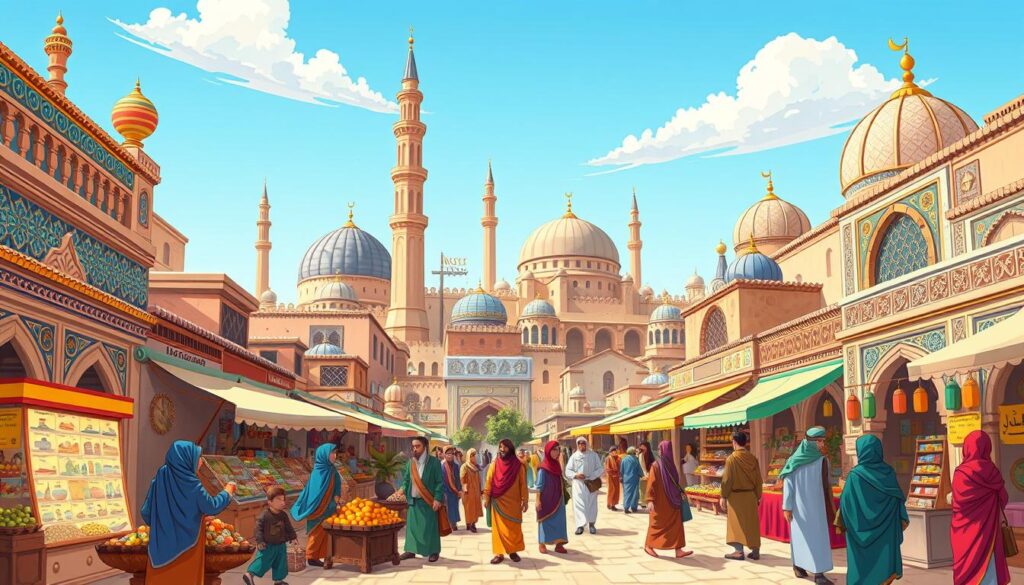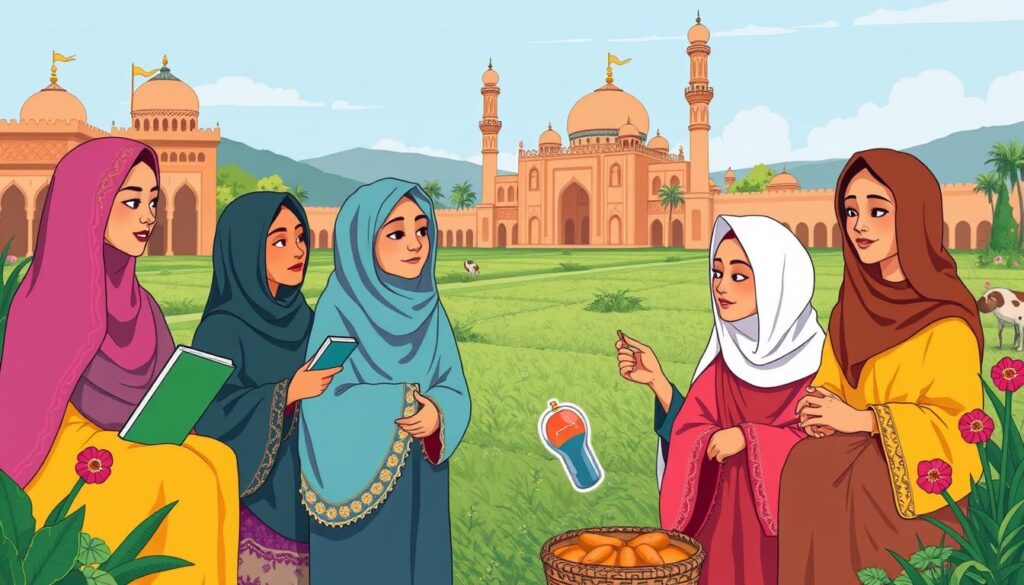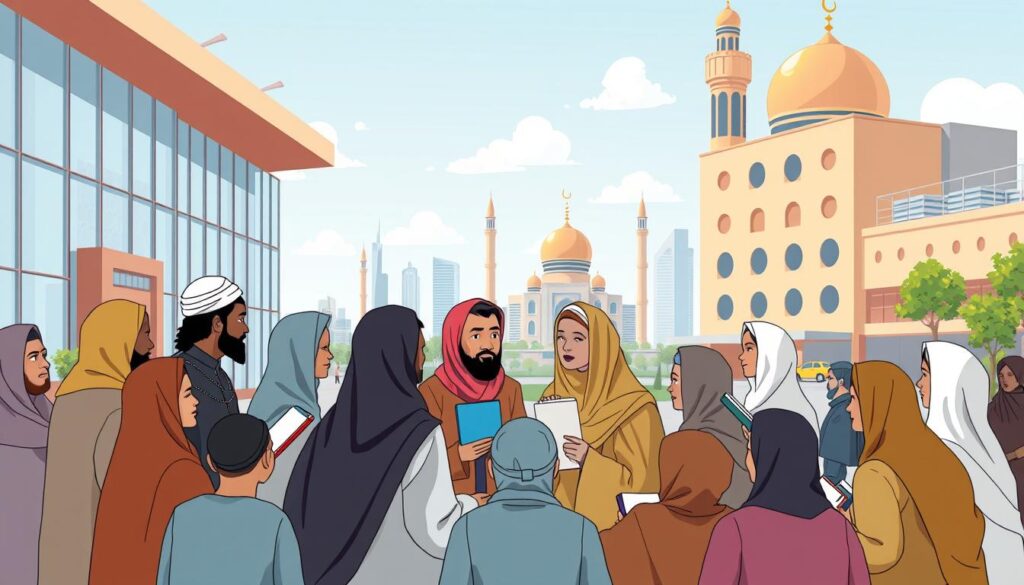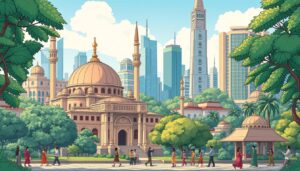As we journey through Islamic history, we find crucial moments and people that changed the Muslim world. It began with Islam’s creation, a period of knowledge and growth. We look at important figures like Prophet Muhammad, who still inspires many today. By studying these events, we learn more about the rich history they left.
This journey not only marks important times but also brings us closer together. We rely on trusted sources for insights that respect and enlighten. Let’s explore together how Islamic civilization has shaped our world, past and present.
Key Takeaways
- Islam emerged in the 7th century, transforming societal norms and values.
- Key figures like Prophet Muhammad laid the foundations of Islamic teachings.
- Understanding Islamic history provides context for today’s global dynamics.
- Islamic contributions in various fields have significantly impacted modern civilization.
- Empowerment and communal responsibility are central themes in our exploration.
The Birth of Islam: A Transformative Era
The seventh century brought Islam into the world, changing it forever. Prophet Muhammad played a central role during this time. His revelations deeply affected millions. Insights from our Islamic history studies show the depth of faith and how society changed.
The Life of Prophet Muhammad
Prophet Muhammad’s life is key in understanding Islamic civilization. Born in Mecca, he overcame many challenges and gave people hope. His leadership unified different tribes, creating a community focused on charity and justice. This unity was the foundation of the early Muslim community, connecting followers closely.
The First Revelation and Its Significance
In 610 CE, the first revelation marked Islamic faith’s start. It happened in the Cave of Hira, beginning Prophet Muhammad’s and his followers’ transformative journey. It led the community to think about their values, pushing them towards greater moral and spiritual depths.
The Early Muslim Community
The story of the early Muslim community is about overcoming tough times. Formed around Prophet Muhammad in Medina, they built new ways of living and governing. Through unity and a shared goal, they not only grew stronger but also spread their faith far and wide.
| Key Aspects | Details |
|---|---|
| Time Period | 7th century CE |
| First Revelation | 610 CE in the Cave of Hira |
| Prophet’s Role | Leader, reformer, unifier of tribes |
| Community Formation | Establishment in Medina |
| Core Values | Charity, justice, community |
The Spread of Islam: Conquests and Cultural Exchange
Islam spread quickly in its early days, changing many areas significantly. This growth happened through battles and sharing cultures, creating a varied Islamic world. We’ll look at the Rashidun Caliphate, the Umayyad Dynasty, and the importance of trade routes in connecting different cultures.
The Rashidun Caliphate
The Rashidun Caliphate, from 632 to 661 CE, started Islam’s expansion. Led by the first four caliphs, Muslims quickly took land from the Byzantine and Persian empires. This time was about showing strength and bringing Muslims together. Learning about this era helps us understand how Islamic rules and government started in these new places.
The Umayyad Dynasty’s Expansion
From 661 to 750 CE, the Umayyad Dynasty grew Islam’s reach massively. It spanned from Spain to the Indus Valley. This period was crucial for battles and sharing cultures, welcoming diverse groups and traditions. The Umayyads helped blend cultures, impacting art, building styles, and rule across their large territory.
Trade Routes and Cultural Interaction
Key to Islam’s spread were the wide trade paths, especially during the Abbasid Caliphate. These routes didn’t just move goods, but also ideas and ways of life. Muslim merchants were vital in linking different areas, enriching places like Southeast Asia and Africa. Big coastal cities turned into lively trade centers, growing Muslim communities and boosting cultural exchanges.

The Golden Age of Islam: Innovation and Learning
The Golden Age of Islam, which lasted from the 8th to the 14th century, was a time of great scientific and cultural growth. It was a crucial era for Islamic studies, with key contributions in science, math, and the arts from Muslim scholars. This period deeply influenced the intellectual scene in the Muslim world and elsewhere.
Advances in Science and Mathematics
Muslim scholars made major breakthroughs during the Golden Age of Islam. They introduced zero and the decimal point, improving on earlier number systems. The algebra that Al-Khwarizmi developed laid down principles still used today. Also, the creation of observatories in places like Baghdad improved the study of stars and planets significantly.
Al-Zahrawi’s surgical techniques also marked a significant advance in medicine, showing innovation that continues to benefit us.
Contributions to Philosophy and Arts
Beyond science, this era shone in philosophy and the arts, showing unmatched cultural depth. The House of Wisdom in Baghdad, through its translation movement, saved knowledge from Greek, Roman, and Persian civilizations. These efforts inspired many and greatly added to global intellectual traditions. They resulted in stunning architectural works that amaze us to this day.
The Role of Muslim Scholars
During this Golden Age, Muslim scholars were true polymaths, diving into various fields. Their collaborative work created a rich environment of innovation and knowledge sharing. Figures like Ibn Sina, who wrote “The Canon of Medicine,” epitomized this era’s spirit, with medical texts redefined and knowledge spread widely. Their legacy still influences many modern fields, highlighting the lasting impact of their scholarship on human progress.
| Field | Key Contributions | Notable Scholars |
|---|---|---|
| Mathematics | Introduction of algebra, principles of flight | Al-Khwarizmi |
| Astronomy | Establishment of the first observatory, Arabic star names | Nasir al-Din al-Tusi |
| Medicine | The Canon of Medicine, advancements in surgical techniques | Ibn Sina, Al-Razi |
| Philosophy | Preservation and translation of classical texts | Al-Farabi |
| Arts | Architectural innovations, contributions to visual arts | Various anonymous artisans |
The Role of Women in Early Islamic Society
Early Islamic society valued women highly, changing the rules of the past. The Quran clearly states women’s rights, granting them honor, respect, and a role in society. This was a big change, letting women learn, do business, and even join in fights.
Women’s Rights in the Quran
The Quran brought big changes to how women were seen. It made education important for all Muslims, men and women alike, aiming for equality. Women got the right to own property, which was new compared to the past. They also received money during marriage, showing they had control over their lives.
Prominent Women in Islamic History
History remembers many important women in Islam. Khadijah, Prophet Muhammad’s (PBUH) wife, was a strong business leader who helped the Prophet when he started his mission. Aisha bint Abu Bakr was important for her knowledge, sharing many teachings of Islam. Fatima al-Fihri started the oldest university, proving women’s power in education and leadership.
The Evolution of Women’s Roles
Over time, women’s roles kept changing. Nusaybah bint Ka’ab and Umm Salim bint Malhan showed bravery in battles, areas usually ruled by men. Women’s involvement in business, learning, and social life grew. They started having a bigger impact, helping shape their communities and culture.

| Rights | Description |
|---|---|
| Right to Education | Obligatory for every Muslim, male and female. |
| Inheritance Rights | Women allowed to inherit property, ensuring financial security. |
| Financial Independence | Dowries legally belong to women, affirming their independence. |
| Marriage Rights | Women can accept or reject marriage proposals. |
| Role in Society | Participation in trade, social matters, and military campaigns. |
This history fights wrong ideas about women’s rights in Islam and shows how early Islamic society supported women’s empowerment and active roles in society. For more details, you can read about women’s rights in Islam. Learning about this past helps us understand the big role women played in history.
Key Dynasties and Their Contributions
We dive into key dynasties that deeply influenced Islamic history. Each one helped grow Islamic civilization. They also encouraged growth in culture, science, and religion that we still see today.
The Abbasid Caliphate: A Cultural Center
The Abbasid Caliphate started in 750 CE, marking the Islamic Golden Age. It covered vast areas and was a key cultural and educational hub. The House of Wisdom in Baghdad was significant. It allowed scholars to translate Greek texts into Arabic. This moved forward knowledge in many areas like medicine, mathematics, and philosophy.
- They made medical books, like Al-Taṣrīf by Abu Al Qasim Al Zahrawi, changing how medicine was practiced.
- They also made big steps forward in algebra and creating algorithms.
- Their cultural exchanges from the Atlantic to India bred a mix of ideas that helped society progress.
The Ottoman Empire’s Legacy
The Ottoman Empire thrived from 1299 to 1922 and stretched across three continents in 1683. Famous for stunning buildings and smart governance, it left a deep mark on world history.
- This empire was known for mixing cultures, boosting trade and art.
- Its art contributions, like building beautiful mosques and palaces, show its importance.
- The governance systems they set up influence how countries are run today.
The Safavid Influence
The Safavid Dynasty led from 1501 to 1736, making its mark with art, architecture, and promoting Shia Islam. Under Shah ʿAbbās I’s rule from 1588 to 1629, it saw military changes and grew its territory.
- Its architecture, with amazing mosques and gardens, showed Persian creativity.
- Their cultural efforts made Shia Islam more prominent in the area.
- The era’s cross-cultural exchanges enriched conversations between diverse traditions.
Major Historical Conflicts in Islamic History
Throughout Islamic history, significant conflicts have shaped the Muslim world’s social and political landscape. This Islamic history analysis shows a trend of struggles, alliances, and changes, mostly due to cultural and land disputes. These conflicts have deeply influenced religion and politics in many areas.
The Crusades’ Impact on Islam
The Crusades were a key time of conflict, with European Christians fighting from the late 11th to the late 13th centuries. These battles changed Muslim-Christian relations, leading to lasting tensions and cultural exchanges. Crusades led to more military and diplomatic actions in the Islamic world, making Muslim leaders join forces, affecting future relations and land borders.
The Mongol Invasions and Aftermath
The 13th-century Mongol invasions mark a critical point for Islam, taking over vast areas. Their attacks left cities like Baghdad in ruins, hurting the Islamic world’s cultural and educational heart. Despite the destruction, Muslims later bounced back strongly. They adapted and reformed, leading to a new period where culture and trade blossomed anew.
Sectarian Conflicts: Sunni vs. Shia
The Sunni Shia divide is a long-lasting issue in the Islamic community. It started from leadership disputes after the Prophet Muhammad passed away, leading to various conflicts over time. These issues have caused violence, affecting modern societies and national identities. Understanding these historical conflicts is key to grasping their impact today.

Islamic Empires’ Influence on Global Trade
The Islamic empires had a big impact on global trade from the 7th to 15th centuries. Muslim traders became important in many markets. They linked Africa and Eurasia, creating trade that brought different places closer.
The Silk Road was key for trading goods and ideas, making cultures mix more. This helped different civilizations understand each other better.
The Silk Road and Muslim Traders
Muslim traders were the main players on the Silk Road, making trade and cultural exchanges better. They connected the Islamic world with far-off places like China. Thanks to them, people could enjoy luxury items from distant lands.
This trade also introduced Arabic silver coins far and wide, showing the reach of their trade networks.
Innovations in Commerce and Business Practices
The Islamic world brought new ideas to how we do business. They made systems like Hawala for safe money sending and waqf trusts to help fund public services. These ideas helped early market economies grow, showing advanced trade and financial skills.
Cultural Exchanges through Trade
Trade helped share culture between Islamic and other societies. As traders hit the road, they spread art, science, and big ideas. This blending of cultures spread Islamic studies too, tying different nations together.
These exchanges showed how trade can change the world, bringing people and ideas together.
Modern Reform Movements in Islam
In our look at modern Islamic reform, we see how colonialism’s history greatly influenced Muslim societies. This era sparked a search for independence and identity, making Muslims rethink their customs and ways. Amid these changes, various reform movements have come to tackle the issues from colonial times and today’s society.
The Impact of Colonialism
Colonialism deeply changed Islamic societies. Colonial rulers introduced new social orders, breaking from traditional ways. This led to soul-searching among Muslim scholars, trying to blend faith with the changes from colonial rule. Movements started to promote a return to key Islamic values, focusing on self-rule and cultural renewal.
Contemporary Islamic Thought Leaders
Leaders like ‘Abd al-Karim Sorush and Amina Wadud have become crucial in modern Islamic discussions. They show how Islam’s teachings can solve modern problems. Sorush merges religion and democracy, pushing for human rights and justice. Wadud has reexamined the Qur’an, advocating for fair treatment of women in Islam, giving them a stronger place in religious stories.
Movements for Reform and Revival
Islamic reform and revival movements have various aims and approaches. For instance, the Muslim Reform Movement, started in 2015, works to match Islamic values with today’s human rights ideals. Since the 1990s, Islamic feminist movements have stressed gender equality and justice, questioning old interpretations that sideline women. This spark of conversation and action shows a deep desire for a fairer future, emphasizing learning and empowerment for everyone.

The Legacy of Islamic Civilization Today
Islamic civilization has greatly influenced the modern world. From the 7th to the 15th century, during its Golden Era, it made key foundations in medicine, chemistry, and algebra. The creation of places like the Bayt al-Hikma in Baghdad and Al-Zaytuna university shows the importance we place on learning and preserving knowledge. These institutions were crucial in forming not just Islamic societies but the entire world’s knowledge pool.
Contributions to the Modern World
The effects of Islamic civilization cover many areas. For example, Muslim hospitals provided free care way before Europe did, showing our deep tradition of kindness and community support. Important texts by Al-Razi and Abu Ali Sina were used in European medical schools for many years. Also, Qasim al-Zahrawi’s work on surgery still affects today’s medical procedures.
Continuing Cultural Influence
Islam’s cultural impact is still strong around the world, blending traditions and bringing people together through shared history. The influence of Islamic art, philosophy, and social principles enriches societies everywhere. This appreciation helps communities grow closer, building a sense of unity and respect.
The Future of Islamic History Insights
We look forward to exploring more about Islamic history and its teachings. Encouraging ongoing learning and the spread of values like compassion is important. Supporting groups like the Umar Khan Charity Organization helps us contribute to sustainable humanitarian work. It’s part of our dedication to Islamic teachings. Working together, we can use the wisdom of Islamic civilization to make a better world.






